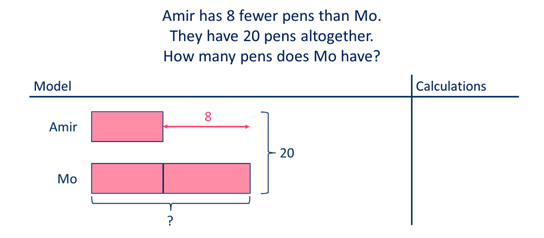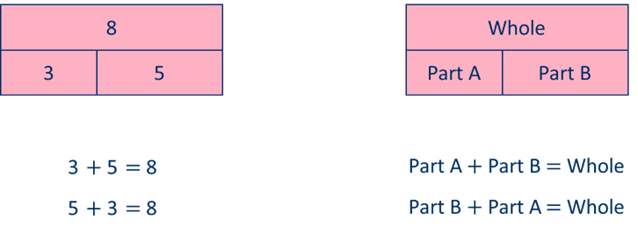Exploring Bar Model Illustration Techniques: A Comprehensive Overview to Picturing Math Concepts
Bar design attracting methods act as an important resource for both instructors and pupils in envisioning mathematical principles. These versions simplify complicated numerical relationships, helping in the comprehension of enhancement, department, subtraction, and reproduction. This guide describes effective strategies for implementing bar versions, cultivating active involvement and real-world links. As readers discover the functional applications and mentor pointers, they will certainly reveal how these techniques can change their approach to maths.
Comprehending the Basics of Bar Version Illustration
Bar design attracting functions as an effective visual device in mathematics, assisting in the understanding of problem-solving strategies and numerical connections. This method entails standing for numbers and their relationships via rectangle-shaped bars, making it easier to envision procedures such as enhancement, multiplication, division, and reduction. Each bar's size matches to a details value, allowing students to contrast quantities and understand proportions plainly.
To create a bar version, one begins by recognizing the issue's key aspects, commonly simplifying right into components that can be aesthetically stood for. In an easy addition problem, two bars can be drawn, with their lengths standing for the addends. The mixed size highlights the sum. On top of that, bar designs can be adapted for more intricate problems, consisting of fractions and proportions, by changing benches appropriately. Understanding these fundamentals lays a strong foundation for reliable analytic and deeper mathematical comprehension.
Advantages of Making Use Of Bar Designs in Mathematics
Using bar models in maths uses numerous advantages that enhance understanding and comprehension. These graphes help students in comprehending complex principles by breaking them down into convenient parts. Bar designs provide a clear framework for showing relationships in between numbers, making abstract ideas a lot more concrete. They promote a deeper understanding of mathematical procedures and assist in analytical by allowing students to imagine the data they are collaborating with.
Bar versions support the advancement of essential thinking skills, as students must assess and translate the aesthetic details to attract conclusions. This method urges energetic involvement with the product, enhancing retention and mastery of mathematical concepts. By promoting a solid foundation in visual literacy, bar designs encourage learners to come close to various mathematical challenges with confidence. On the whole, the assimilation of bar versions into maths education and learning shows advantageous in growing both understanding and analytical abilities amongst trainees.
Using Bar Models to Addition and Reduction
Bar models work as a reliable device for visually representing addition and reduction troubles. By highlighting the connection between numbers, they improve understanding and help with analytical. Furthermore, real-life applications of these designs can help learners understand mathematical ideas in useful contexts.
Representing Addition Visually
Visual help can significantly improve their understanding of these procedures when trainees come across enhancement and subtraction problems. Bar models work as reliable devices for standing for addition. By dividing a rectangle into sectors that represent the numbers included, students can imagine the connection in between the quantities. If a trainee needs to include 3 and 5, they can produce a bar split right into 2 areas: one area standing for 3 and the other representing 5. This clear representation not only simplifies the addition process however likewise strengthens the idea of integrating amounts. As pupils adjust these visual aids, they establish a much deeper comprehension of addition, leading to boosted analytic skills and better confidence in their mathematical abilities.
Reduction With Bar Models
Subtraction is frequently viewed as a much more intricate operation than addition, bar models can successfully clarify this procedure for students. By aesthetically standing for the quantities entailed, students can much better comprehend exactly how numbers associate with one an additional. In a bar model for subtraction, one bar stands for the overall, while an additional indicates the amount being deducted. This aesthetic difference helps trainees comprehend the principle of "taking away." As an example, if a bar reveals 10 systems, and one more bar standing for 4 systems is eliminated, students can easily see that 6 units remain. This technique not just cultivates understanding of reduction yet likewise aids in developing analytical skills, allowing pupils to visualize their mathematical reasoning and enhance their total comprehension of mathematical concepts.
Real-Life Application Examples
Understanding subtraction through bar models lays a foundation for applying these techniques in real-life circumstances. In numerous contexts, such as budgeting or buying, individuals can visualize exactly how much cash continues to be after expenses. If a person has $50 and invests $20, a bar design can represent the total amount and the invested part, highlighting that $30 is left. Furthermore, parents can make use of bar designs to aid kids recognize the number of more items need to be contributed to finish a collection, such as having three apples and requiring five. This graph simplifies intricate problems, promoting understanding and retention. Inevitably, bar designs offer as effective tools in everyday decision-making, boosting mathematical understanding in functional circumstances.
Imagining Reproduction and Department With Bar Versions
In checking out the application of bar versions for reproduction and division, it is necessary to realize their foundational concepts. Building multiplication designs permits students to envision partnerships in between numbers, while efficient division methods can be illustrated via these aesthetic aids. This approach boosts comprehension and analytical skills in mathematics.
Recognizing Bar Versions
Bar versions offer as an effective aesthetic tool for illustrating the principles of multiplication and department. They allow learners to represent mathematical relationships in an organized format, helping with a much deeper understanding of these operations. In reproduction, bar models show groups of equivalent size, enabling individuals to imagine the complete quantity when integrating these teams. Conversely, in division, bar models assist illustrate how an overall is split right into smaller sized, equivalent parts, clarifying the idea of partitioning. By employing these aesthetic help, pupils can understand the underlying principles of reproduction and department better. This method not just improves comprehension yet additionally supports analytical skills, making bar versions an indispensable asset in mathematical education.
Building Reproduction Designs
Constructing reproduction versions using bar diagrams provides a clear approach for envisioning the process of multiplication. These models allow students to represent reproduction as teams of equivalent parts, making abstract ideas a lot more concrete. To illustrate (3 times 4), a pupil can draw one bar separated right into 3 equivalent sections, each representing four systems. Additionally, producing a second bar with the exact same size reinforces the understanding of duplicated addition, as each section represents one group. This graph not just aids in realizing reproduction however likewise boosts analytic skills. By employing bar versions, students can much better understand connections in between numbers and develop a robust structure for more complex mathematical principles, bring about boosted confidence in their abilities.
Visualizing Division Techniques

Solving Word Problems Making Use Of Bar Design Techniques

In an issue including addition and reduction, trainees can attract different bars for each quantity and then adjust them to discover the solution. This procedure not just clears up the problem but additionally cultivates a much deeper conceptual understanding. Additionally, bar designs can be adapted for various types of word problems, making them versatile throughout different mathematical subjects. Ultimately, making use of bar models can significantly boost trainees' problem-solving abilities by supplying a clear visual path to get to the proper response.
Integrating Bar Models in Different Mathematics Topics
Bar designs can be effortlessly integrated right into numerous math subjects, enhancing pupils' understanding of ideas beyond standard math. In algebra, these visual tools aid in standing for inequalities and equations, enabling students to visualize relationships in between variables. When dealing with geometry, bar models can illustrate the buildings of shapes and spatial reasoning, assisting trainees realize principles like location and perimeter effectively. In data, bar designs facilitate the interpretation of data collections, allowing students to contrast amounts and identify trends aesthetically. Furthermore, incorporating bar designs within dimension topics help in comprehending devices and conversions by providing a concrete representation of quantities. By utilizing bar designs across various mathematical areas, instructors can foster a much deeper comprehension of complicated concepts, thus improving analytical skills and advertising important reasoning (bar model drawing techniques). This versatility shows the utility of bar designs as a fundamental tool for trainees in their mathematical journey
Tips for Teaching Bar Models Properly
Incorporating bar models right into training methods needs thoughtful approaches to maximize their performance. Educators should begin by introducing bar designs with straightforward, relatable instances that pupils can conveniently grasp. This helps to build self-confidence and knowledge with the idea. Progressively enhancing the complexity of issues enables students to apply their abilities gradually. In addition, instructors need to motivate students to develop their own bar versions, promoting energetic interaction and ownership of their knowing.
Integrating joint activities can additionally improve understanding, as trainees talk about and resolve problems in groups. Continuous responses is necessary; instructors ought to give constructive discourse on pupils' bar version depictions to assist renovation. Attaching bar versions to real-life circumstances enhances their relevance, aiding students see the practical applications of their mathematical abilities. By executing these strategies, educators can successfully harness the power of bar designs in their maths instruction.
Frequently Asked Inquiries
Can Bar Models Be Made Use Of in Various Other Subjects Besides Mathematics?
Bar models can certainly be utilized in numerous subjects beyond mathematics. They properly show principles in science, social research studies, and language arts, assisting to aesthetically represent connections, procedures, and concepts for improved understanding across techniques.
What Age Group Is Best Suited for Understanding Bar Models?
Bar models are best matched for kids ages 7 to 12, as they develop concrete thinking skills during this duration (bar model drawing techniques). At this age, students can effectively realize abstract principles through graph and analytic techniques
Exist Digital Equipment for Creating Bar Models?

How Can I Examine Trainee Understanding of Bar Models?
Assessing pupil understanding of bar versions can involve tests, observational assessments, and seminar. Teachers may likewise evaluate pupils' completed designs and their capability to discuss their reasoning, making sure a detailed examination of understanding.
What Are Common Mistakes When Making Use Of Bar Designs?
Common blunders when using bar designs consist of misstating amounts, falling short to properly label bars, confusing addition and reduction, ignoring to make use of consistent scales, and overlooking the value of clear visual separation between various elements.
In enhancement, bar versions can be adapted for much more intricate troubles, consisting of ratios and portions, by changing the bars as necessary. Reduction is usually regarded as an extra complex procedure than addition, bar models can properly clarify this process for students. In a bar model for reduction, one bar represents the overall, while an additional indicates the amount being subtracted. If a bar reveals 10 check here devices, and an additional bar standing for 4 systems is removed, students can conveniently see that 6 systems continue to be. When splitting a total amount into equivalent groups, pupils can attract a long bar to represent the whole and then segment it into smaller bars that suggest each team.